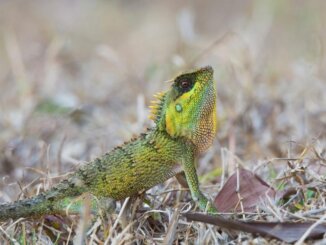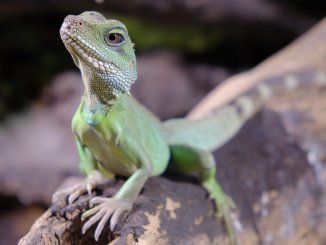The fire skink is a vibrant lizard from western Africa. Fire skinks have red and orange coloring, a golden dorsal, and black and white flecks along the sides of their bodies.
Beginner and experienced hobbyists alike will enjoy the fire skink as this lizard is hardy and easy to care for. Fire skinks are popular pets to keep due to their calm temperament.
Fire Skink Overview
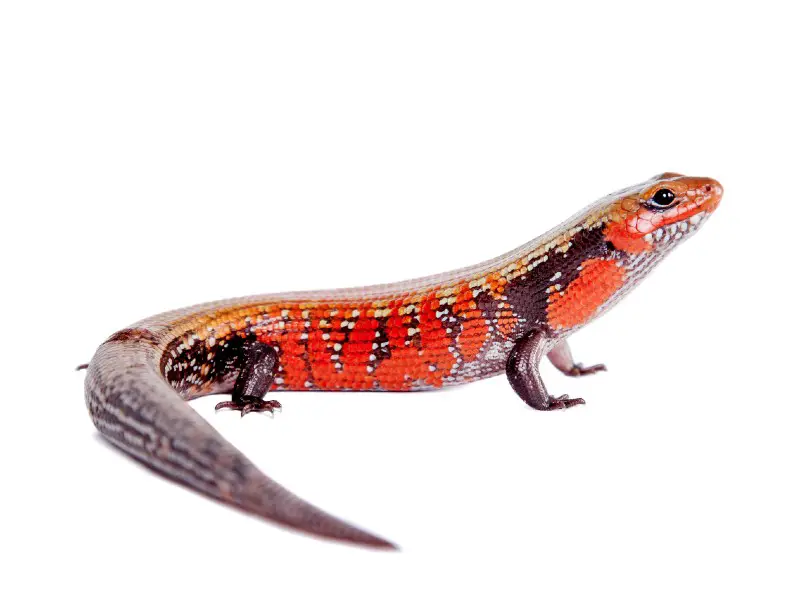
| Common Names: | True fire skink, African fire skink, Togo fire skink |
| Scientific Name: | Lepidothyris fernandi |
| Natural Habitat: | Woodland, forests, and grasslands in West Africa. |
| Adult Size: | 14–15 inches |
| Average Lifespan: | 15–20 years |
| Diet: | Live insects such as locusts, worms, crickets, cockroaches, and occasional pinkie mice |
| Housing: | 40–50 gallon tank with high humidity and moist substrate. The tank should offer three temperature zones ranging from 75–96°F. |
| Experience level: | Beginner |
Origin
The fire skink (Lepidothyris fernandi) is mostly found in West Africa, but is also found in Angola and Guinea. The natural habitats of fire skinks are forests and grasslands with plenty of hiding spaces.
The fire skink is a calm species, but these reptiles may bite and arch their backs if provoked. Fire skinks are often caught in the wild and tamed for hobbyists. Captive-bred fire skinks are becoming more common.
Fire skinks survive in the wild by outrunning predators and blending into the environment. The fire skink will also shed its tail to avoid capture if grabbed by a predator.
Unlike other skinks, fire skinks are oviparous, which means they lay eggs after mating. You should only breed skinks if you are an experienced hobbyist.
Appearance and Behavior
The fire skink is one of the most beautiful skinks with its vivid colors. Fire skinks have bright red and orange bodies with golden-bronze backs. The rest of the body of the fire skink is black with white flecking, stripes, and bars across the sides, underbelly, and legs.
Like other skinks, the fire skink has a long body, short, sturdy legs with sharp claws, and a bulky tail. Fire skinks undergo slight color changes according to their moods and environment.
Gendering fire skinks can be difficult. Male fire skinks are larger than females and are thicker at the base of their tails. Healthy male fire skinks develop a bulge below their ears, known as a jowl.
Females display tails that begin to taper away past their hips. This characteristic can be hard to notice. Fire skinks are often misgendered and expectant breeders may be disappointed when a pair does not breed.
Size and Lifespan
When they’re born, fire skinks are roughly two inches long. Male adult fire skinks can reach up to 15 inches while females are slightly smaller.
Fire skinks may live between 15–20 years in captivity. The lifespan of a fire skink will depend on the level of care it receives and its living conditions. You can extend your fire skink’s lifespan by handling it with care, feeding it a nutritious diet, and creating a good habitat.
Temperament
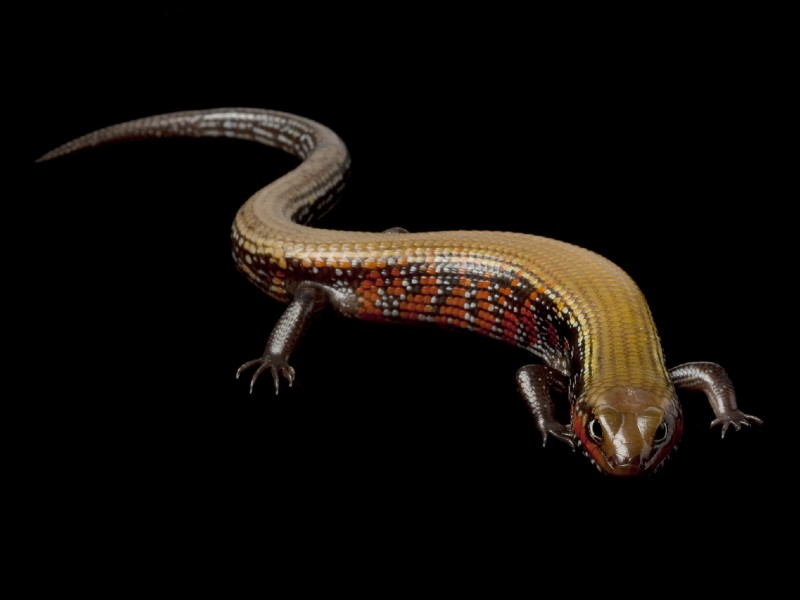
In captivity, fire skinks will burrow deep into the substrate to feel safe. If you create the right environment, your fire skink will likely show off its personality and vibrant colors.
Captive-bred fire skinks will behave differently than ones caught in the wild. Wild skinks are skittish, and you will need to take care while taming your fire skink.
Because fire skinks are diurnal, you’re likely to find them basking during the day. While fire skinks are quite active when they’re tamed, they may hide if they feel threatened.
The fire skink is a calm species and will only bite if provoked. When your skink is tame enough, you may handle it gently. Your fire skink won’t want to be held too much.
You can house a pair of fire skinks in a 40-gallon tank as long as it is a male and female pair. When pairing two fire skinks, you should watch them with care during the breeding season.
Housing Fire Skinks
Fire skinks live in vegetated areas with high humidity and plenty of food sources. You should create a similar habitat by filling the tank with plants and misting often.
You can house your fire skink in a glass or acrylic tank with enough space for it to move around in. You should ensure there are plenty of plants and caves for your fire skink to hide when it feels threatened. Your tank setup should have three temperature areas.
Enclosure size
The smallest tank size for a fire skink is a 20-gallon tank, but a 40-gallon tank is better. Fire skinks will use all the space they have, and a pair will need the larger tank.
The tank should have more width than height to give the fire skink more space to move. Fire skinks enjoy climbing on branches and driftwood, so a bit of height is a good idea. You may often find your skink basting on a branch in the warmer areas of the tank.
The smallest size for a 20-gallon tank is 36 inches wide, 12 inches high, and 12 inches deep.
Lighting
Fire skinks are active during the day. You should provide them with 10–12 hours of light during summer and spring. In the winter months, you should reduce the daylight hours to between eight and 10 hours each day.
The correct lighting for fire skinks is often debated, but your fire skink will benefit from UVA exposure. Placing a 40-watt day bulb above the tank can provide enough exposure.
Fire skinks that have exposure to UVA light will be healthier and will have brighter colors. UVA exposure will also reduce the chance of metabolic bone disease.
UVB light may be beneficial to your fire skink. You can also supplement for a lack of UVB light with calcium dusting on your fire skink’s food. A dual light bulb fixture allows you to provide both UVA and UVB sources for your fire skink.
Temperature and Humidity
Fire skinks need gradient heating to mimic their natural habitat. The heat gradient should create three temperature zones across the tank.
You should keep the hot zone at about 90–95°F. Place a flat rock and branches in this area for your fire skink to bask on.
The middle zone should be around 84–86°F and should make up the biggest section in the tank. The cooler side of the tank and the nighttime temperatures should be 75°F.
To create the heat gradient, use an under-tank heater with dome lights placed above the tank. Larger tanks may need side heaters to achieve the right temperatures.
You should place up to three thermostats inside the tank to monitor all three zones. You should never place heat sources inside the tank as the heat can burn your fire skink.
Fire skinks come from high-humidity areas, so your tank must stay humid. The general humidity in the tank should stay at around 60–70% but can drop to around 40% at times.
You can keep the humidity up in the tank by misting once or twice a day. A hygrometer placed inside the tank will help you keep track of the humidity levels.
Substrate and Decoration
Your tank should contain a deep layer of the substrate to allow your fire skink to burrow and create tunnels. The substrate should be about 4–6 inches deep and should stay moist at all times.
The dry substrate can cause respiratory infections, and your fire skink may have a poor shed.
The best substrates for your fire skink tank are cypress mulch, sphagnum moss, or fertilizer-free soil. You can also use peat moss or reptile bark as the substrate.
You shouldn’t use coconut husk as a substrate because it will cause digestion problems if your fire skink eats it. The fire skink tank shouldn’t have a sandy substrate, either.
During shedding, fire skinks need plenty of moisture and will burrow into the substrate. They may use water from a shallow dish to stay moist.
You should add plenty of fake plants to create enough hiding places for your fire skink. Live plants may not survive, as fire skinks burrow and tunnel in the substrate. Add some driftwood and branches to give your fire skink space to climb and bask on a higher ledge.
Adding dense plants to your tank will create a more secure space for your fire skink. You will see the fire skink more often in this tank setup.
You should add flat rocks in the hotter areas to promote basking. You can place leaf litter on the substrate to keep the substrate moist. Adding in caves will offer space for your fire skink to hide and sleep.
Cleaning
To keep your fire skink healthy, you will need to clean the tank often. Remove any waste and mess from the tank and replace the substrate regularly to prevent a build-up of mildew and mold.
You can add micro-insects such as isopods and springtails to the substrate as a natural clean-up crew. You should clean up waste daily with a full substrate change every three or four months.
Clean your lizard’s food and water bowls every day with a reptile-safe disinfectant. You can also use the disinfectant to clean the tank when you replace the substrate.
You can keep your fire skink in a deep container while doing a full clean of your tank.
Fire Skink Care
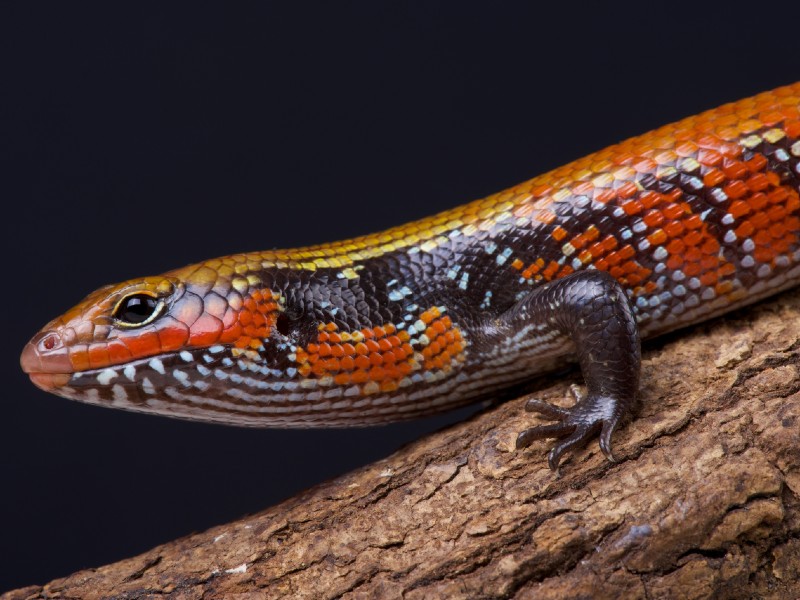
Due to their hardy nature, fire skinks are easy to care for. As long as you create the correct setup and keep your tank clean, you won’t have a problem with looking after fire skinks.
While your fire skink may be timid at first, it may become active in the day if the tank is well set up. Fire skinks need live food up to three times a week.
Food and Water
Fire skinks are omnivores, but often feed on insects. You can feed your fire skink crickets, snails, dubia or discoid roaches, and worms. It’s good to feed your fire skink a varied diet. You can give your fire skink a once-per-month treat of pinkie mice or fruit.
You should feed juvenile fire skinks daily and adults two or three times a week. Feed your fire skink three to five insects at each mealtime. To provide your fire skink with the right nutrients, dust the food with calcium and multivitamins.
Adding a shallow bowl of water into the tank will keep the tank humid and offer water for your fire skink during shedding. Your fire skink may not regularly use the water bowl because it gets its water from the tank’s humidity and food.
Handling
Like many other reptiles, fire skinks are not fond of handling. Once your fire skink is comfortable, you may be able to handle it for short periods.
You must handle fire skinks with care as they’re fast and can get hurt if they’re dropped. Your fire skink may also escape if you handle it in an open space.
You should never grab a fire skink by its tail. A fire skink will shed its tail when grabbed, and while the tail will grow back, it will lose its bright colors.
Fire skinks are safe to be around children but you should watch their interactions carefully. It’s not common, but fire skinks will bite if provoked.
Common Health Issues
Fire skinks are a hardy species, but they may develop certain health issues if they aren’t properly cared for.
Common health issues include:
- Mites
- Ticks
- Bacterial infections
- Metabolic bone disease
- Cryptosporidiosis in wild fire skinks
Your fire skink should stay healthy as long as you keep the tank clean with the correct light and food sources.
Shedding
Fire skinks turn a dull brown color when the skink is ready to shed. Your fire skink may hide in the substrate during this time and not eat for a day or two. After a few days, your fire skink will appear with its bright colors back to normal.
Breeding
Fire skinks are easy to breed, but captive-bred fire skinks are still rare. To breed fire skinks, you should feed the pair a healthy diet before breeding. Fire skinks breed from early spring to late autumn.
To encourage breeding, you should keep the tank at 80°F and increase the daylight hours to longer than 12 hours.
- While the female develops the eggs, keep the basking temperature at 96°F.
- After 30 days, the female fire skink will lay between three and six eggs per clutch.
- When you notice the female has lost weight, you should look for the eggs. Keep the eggs the right way up during incubation.
- The hatchlings will hatch within 65 days and should stay in the incubator at 85°F until all the eggs have hatched.
- Juvenile fire skinks should stay in a smaller tank with the same setup as the adult tank. You should feed the young fire skinks small crickets until they’re large enough to eat a normal adult diet.
- If the juvenile fire skinks nip at each other’s tails, they need more food. When they’re large enough, you can leave a tray of mealworms in the tank.
- After a month, the young fire skink should be ready to move to an adult-sized tank.
Choosing and Buying a Fire Skink
Fire skinks are difficult to find but are growing in popularity. You will likely find fire skinks at reptile expos or through online sellers. Fire skinks cost between $40 and $50.
Fire skinks caught in the wild will need more taming than captive-bred skinks. If you’re a beginner hobbyist, you should find a captive-bred skink, as it will be easier to care for.
Your fire skink will provide a beautiful display of colors for you to enjoy. Remember to keep the tank clean and the humidity high enough.


